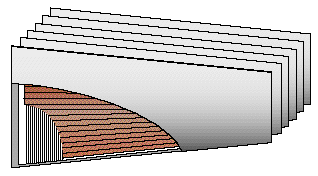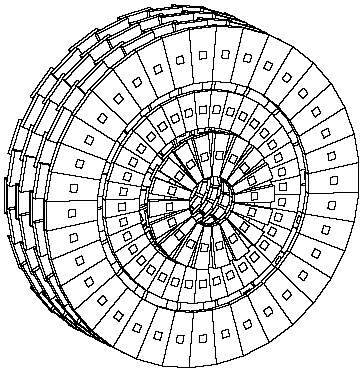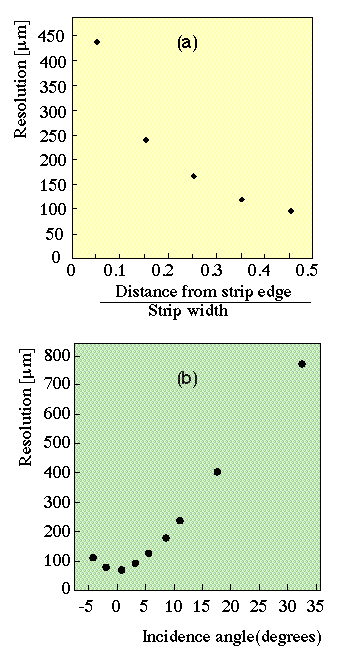
Figure 6: Sketch of a forward muon chamber.

Figure 7: Arrangement of the chambers of the forward muon detector (iron yoke not shown).
3 Forward Muon Detector
The muon detector in the forward region of CMS is supposed to
work in an environment that is quite different from the one of
the central region. There is a much higher occupancy (growing
from few Hz/cm2 to more than 100 Hz/cm2) and the chambers are
immersed inside a sizeable magnetic field.
The natural choice for a detector operating with good performance
in such a delicate environment is multiwire proportional
chambers.The resolution requirement for the detector is again
~100Ám per station) to assure a reasonably good standalone
momentum measurement. This resolution can be achieved only using
segmented cathode analog readout.
A sketch of a chamber is shown in Figure 6, where we notice that
the readout strips are radial to allow a direct j precise measurement. The wires are readout
in groups in order to reduce the readout channels and therefore
provide a coarse measurement of the radial coordinate. The
redundancy is obtained building a chamber as the composition of
six staggered layers of wires. The occupancy can be reduced only
using relatively small chambers and therefore the acceptance
requirements implies the superposition of the chambers to reduce
the dead areas caused by the supporting frames, producing the
wheel-like detector drawn in Figure 7.

Figure 6: Sketch of a forward muon chamber.

Figure 7: Arrangement of the chambers of the forward muon
detector (iron yoke not shown).
The innermost chamber is placed inside the full 4T field.
Hence the magnetic field distorsion effect on proportional
chambers is not anymore negligible, but since this field is
constant the distorsion can be compensated tilting the wires by
the Lorentz angle value (a = 25
degrees for the foreseen gas mixture).
Several prototypes of the endcap chambers were exposed to muon
test beams [4]. The single hit measured resolution as a function
of the distance from the strip edge is reported in Figure 8a,
where the usual dependence of strip measurement on the particle
crossing point is evident. The planes staggering anyway assures
that some high resolution measurement is always available for
every track. Hence, once the six hits are averaged using their
proper resolution, the target global resolution per six planes
can be achieved. The degradation of the single hit resolution
with respect the muon track inclination, shown in Figure 8b, is
large, but tolerable.

Figure 8: Resolution versus particle crossing position w.r.t. (a)
strip edge; (b) incident angle.